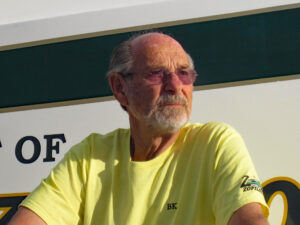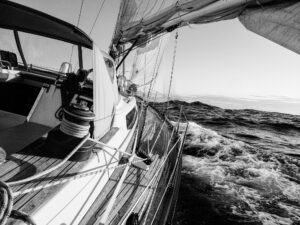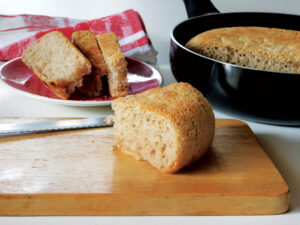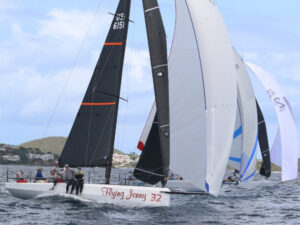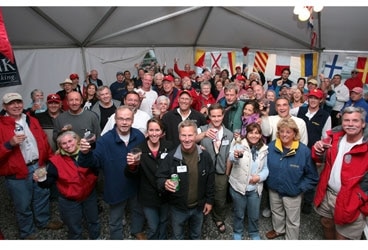
The Caribbean 1500 fleet is ready. The workshops-on offshore safety, fuel, water, food, seasickness, navigation, passagemaking strategy, weather, the Gulf Stream, diesel troubleshooting, fishing, circumnavigating, and the ladies’ roundtable-are concluded. The demonstrations and presentations-of life rafts, flares, weather reports via e-mail-are over. Safety inspectors have been in and through each of the 45 rally boats; the shuttle-bus runs to West Marine are winding down. Even the crowds at the dinners and cocktail parties in the main tent have thinned out-most crews are busy squirreling away last-minute provisions or studying the Gulf Stream’s latest wiggles for the 1,280-mile passage from Hampton, Virginia, to Tortola, in the British Virgin Islands. The rally fleet is ready-but the weather isn’t.
With a powerful low-pressure system churning northeastward up the Eastern Seaboard toward the Virginia coast, Caribbean 1500 founder and impresario, Steve Black, who presides over the event with the folksiness of Garrison Keillor and the wisdom gleaned from managing 18 previous rallies (he’s sailed in 14 of them), chooses to delay the start five days to let the gale pass by. A November passage from the U.S. East Coast to the Caribbean, as veteran cruisers and delivery skippers will tell you, is tricky: Dodge the early season winter storms, negotiate the mercurial Gulf Stream, and find favorable breeze for as many days as possible all while keeping an eye out for post-season hurricanes forming in the tropics.
Black works with a team of meteorologists at Commanders’ Weather, a forecasting service, to pick the best weather window for the rally, and he keeps the fleet updated with a daily briefing. As the new jump-off day approaches and the warm waters south of Cuba brew up Hurricane Paloma, Black and Commanders’ Weather decide to route the fleet well east of the rhumb line, to within a day’s sail of Bermuda-a prudent bailout plan should Paloma make it past the cold water and cold-air masses north of Cuba. After an additional one-day delay to allow the post-gale 10- to 14-foot seas outside the Chesapeake to subside, the rally is ready to roll. Meanwhile, crews have kept busy with their preparations, perhaps also pondering the realities of passagemaking in company: What are the pros and cons when you choose to sail with the herd?
Certainly, anti-rally cruisers are quick to point out that “safety in numbers” is an illusion; once at sea, you’re on your own. Nevertheless, do folks joining the Caribbean 1500 expect to have a safer passage? “It’s not the proximity of other boats but the commonality of purpose that’s the most valuable aspect of the event,” says Black. “You’re able to get troubleshooting help and immediate answers to your questions about equipment, weather, and how to make a passage-right down to how to properly secure a tender on deck or in davits. And you get the added benefit of a safety inspection by a veteran offshore sailor.”
Indeed, a strong emphasis on safety permeates the Caribbean 1500, even though no safety checklist, after all, can guarantee a safe passage. Still, our safety inspector, Jeff Chabot, who’s sailed several 1500s in his own boat, not only works through the required items on the checklist but walks my wife, Harriet, and me through the nitty-gritty of what to do in the event of a crew-overboard, a holing, a dismasting, or a steering failure on our Dolphin 460, Hands Across the Sea. After we arrived in Tortola we found there’s a kind of safety postmortem, too, embodied in the form of Davis Murray, Steve Black’s ocean-sailing compadre and Caribbean 1500 go-to guy. (For more on Murray, see “The Master of Deviation,” September 2008.) Any boat arriving with a gear failure soon finds Murray up the mast or down in the engine room determining the cause of the breakdown and assessing how the crew handled it. Why and how did the part break? Did you have the right spares/repair parts/tools/know-how to get it up and running? The information Murray uncovers is incorporated into the next year’s safety requirements and inspection.
Another feature that attracts cruisers, particularly those new to passagemaking, is the event’s 200-strong volunteer-crew service. Black notes that about a third of the 2008 entries haven’t made a passage of longer than two nights; most of the rest of the fleet are 1500 veterans. Before each event, Black plays matchmaker, getting 1500 veterans onto boats with little or no offshore experience and matching volunteer crew with specific boat types and boats. For Kent and Carol Bradford and their Bristol 45.5, Destiny, for example, Black lined up 1500 vets Galen Hake and Mike Eslinger-both are Bristol 45.5 owners, and both have sailed their own boats offshore. Ultimately, nearly every boat in the rally carries a volunteer sailor.
Finally, the attraction for many of this and other rallies is camaraderie-and, I suspect, curiosity. Wanting to make new friends who are going where you’re going is a natural, and that leads to dockside kibitzing about approaches to everything from passagemaking to rum-drink recipes to the cruising life. And as everyone eyes everyone else’s boat and gear, there’s plenty to be learned and applied to your own boat. The gathered Caribbean 1500 fleet is a kind of showcase of well-equipped modern cruising boats averaging 48.5 feet in length; most are sturdy performance-oriented boats-from the likes of Hallberg-Rassy, Beneteau, Jeanneau, Amel, Catana, Passport, Tayana, Hylas, and Hinckley-rather than ex-raceboat designs, and all are loaded with state-of-the-art navigation, communication, and liveaboard systems. I realize that there’s not a Tahiti ketch or a shred of baggywrinkle to be found.
The start, gray and windless, goes off like the Oklahoma land rush. Throttles are floored as the fleet steams out of Chesapeake Bay to hollers and horn honks. Those new to rallydom, trying vainly to sail, are left behind in a weed patch of bouncing wakes and diesel smoke. Is this supposed to be a motorboat race? The answer is that by design, motoring is part of the Caribbean 1500; most years, the fleet ends up motoring 25 to 30 percent of the way.
“I don’t want anything to stop boats from completing the passage in good order,” explains Black, who says cruisers don’t want to sit becalmed as unfavorable weather zooms in on them. In the Rally Class, where boats race in divisions with Caribbean 1500-assigned handicaps, engine time is penalized-motoring to victory isn’t possible; motoring to defeat is more like it. Cruising Class boats aren’t racing, and thus those skippers are free to motor all they want.
The first night, crossing the Gulf Stream is a breeze, beam-reaching in 15 knots with some lumps and bumps but no breaking seas. But the second night, a 25- to 30-knot pre-frontal southwesterly rag-dolls the fleet with squalls and square-topped seas and seems to set the tone for the rest of the passage: stiff breeze and boisterous seas, coming at you from uncomfortably far forward of the beam. The breeze is lighter for the next 36 hours, but gradually it shifts and fills in solidly from the east. Most of the fleet, which has made substantial easting by heading toward the suggested “Bermuda bailout” waypoint, is well positioned to straight-line it to Tortola. The next four to six days feature an unrelenting 20 to 25 knots blowing at 50 to 70 degrees apparent, enough 30-knot squalls to teach you not to shake out the reefs, and warm water exploding over bows, cabin tops, and dodgers. Conditions are testing but not tempestuous-breakdowns among the fleet include torn sails and broken sail hardware, steering glitches, and refrigeration, genset, and engine troubles. The things that can be fixed at sea get fixed. The unfixables are coped with, and the fleet soldiers on.
As the boats trickle into Tortola and dry out at the Village Cay docks, I worry that I may have miscalculated the buoyancy of cruisers. I wonder, for example, how Chris and Christine Ellsay, on their first-ever ocean passage, had the energy to stand three-hours-on/three- hours-off watches while managing their three under-10 kids on Stray Kitty, a PDQ 42 catamaran. “Normally, we allow the kids only one video a week,” Christine offers by way of explanation, “but for this passage we loaded up-Disney, DreamWorks, you name it-and the kids watched videos nonstop. They even learned to put themselves to bed.”
And how would newlyweds Seth and Elizabeth Hynes on Honeymoon, a Lagoon 380 cat, come out of this bruising passage? After all, it was their first time offshore, and they’d snapped the mainsail headboard car and been squall-slapped aplenty. Before they set off, Elizabeth had vowed that they’d continue cruising if they had a good passage. “I didn’t think I’d ever see land again!” Elizabeth hooted, clad in bikini and sailing gloves, as Honeymoon pulled in. Then Elizabeth delivers the verdict: “Now that we’ve survived this, the best is yet to come! We’re going cruising!”
And while I’m convinced that even brand-new cruisers quickly pick up an unsinkable gene, I wonder if anyone actually enjoyed this blowy, wet, bumpy trip. Then I meet Jorge Zlatar and Isabel Cumsille, Chileans on Excalibur, a ketch-rigged Amel 53. Jorge had taken Excalibur east-way east, 100 miles past the longitude of Bermuda-and when the time came to head for Tortola-Excalibur sailed a whopping 1,700 miles in total-the wind was blessedly further aft and far less squally than for the rest of us. “We read, we drank wine, we talked, we did needlepoint,” says Jorge. “We had a wonderful passage!”
Maybe that’s the secret to sailing in a rally, to riding with the herd. Sure, it’s great to share information and make new friends, and it’s a buzz to collect a pickle dish by beating some other boats to the finish line. But the most important thing to remember is: Once you cast off, you choose your own path.
After a winter spent in the Caribbean, Tom and Harriet Linskey sailed back up the U.S. East Coast and spent the summer aboard Hands Across the Sea in Newport, Rhode Island, and Camden, Maine. They’ll return to the Caribbean in November with lots of books for the local children.

